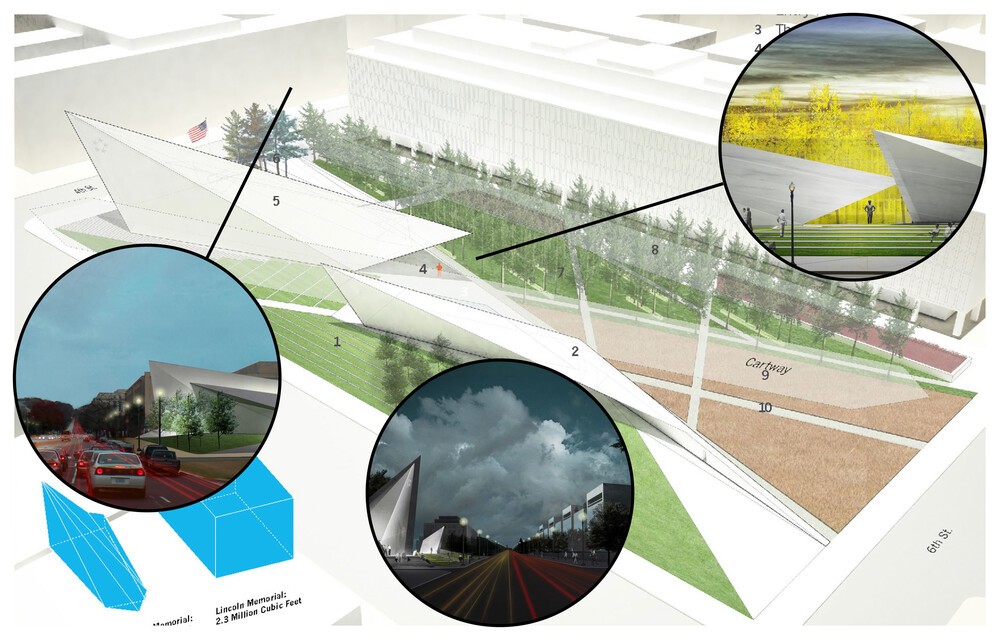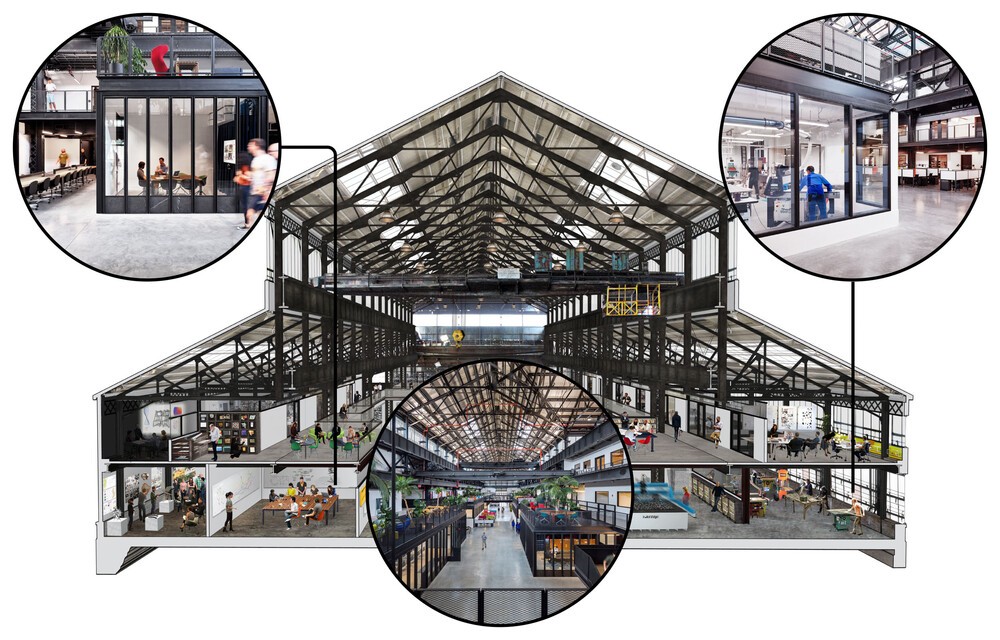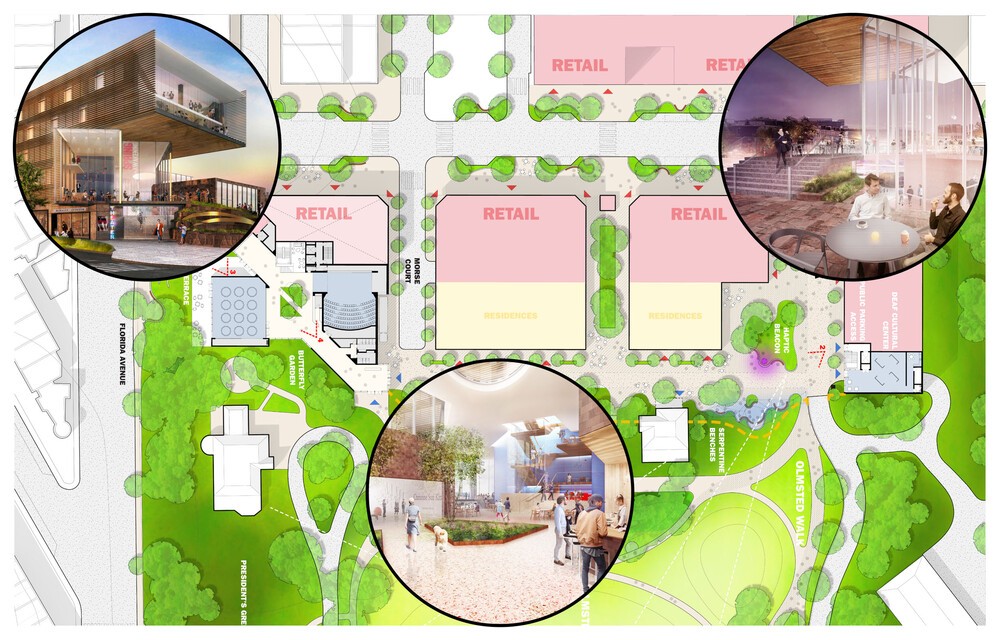Psychospatial Design
In the last few years scientists and designers have begun to collaborate on ways of measuring that impact, in tangible, statistically demonstratable ways, leveraging our current understanding of neurology with new suites of software and hardware, as well as a more rounded, inclusive understanding to the user experience.
At Marvel we have experimented with neuroarchitectural (our internal term is ‘psychospatial’) design since 2008, beginning with our involvement in the Dwight D. Eisenhower Memorial design competition in Washington, DC. We have since continued our research through projects such as the Gallaudet University campus, where we developed "DeafSpace" principles to improve the psychological well-being of deaf and hard-of-hearing students.
Marvel is committed to incorporating innovative tools and approaches that enrich the work of our architects, interior designers, and landscape architects. Neuroarchitecture represents one of these groundbreaking tools. By incorporating insights from neuroscience into our design processes, we aim to create spaces that are not only beautiful, but foster well-being, productivity, and emotional resonance for those who inhabit them.
 Marvel's proposal for the Dwight D. Eisenhower Memorial, a 4-acre site on Independence Avenue SE, focused on the sensory journey of visitors throughout the site. The design features two axes representing Eisenhower's life and the American Century, culminating in an open space where Eisenhower the Supreme Commander takes the world stage. Inner walls of the pavilions feature lenticular images on 3D-milled marble that provide impressions of Eisenhower's achievements. An interactive digital application connects with visitors' individual experiences, and a varied landscape of the memorial ground celebrates the importance of public space and public service.
Marvel's proposal for the Dwight D. Eisenhower Memorial, a 4-acre site on Independence Avenue SE, focused on the sensory journey of visitors throughout the site. The design features two axes representing Eisenhower's life and the American Century, culminating in an open space where Eisenhower the Supreme Commander takes the world stage. Inner walls of the pavilions feature lenticular images on 3D-milled marble that provide impressions of Eisenhower's achievements. An interactive digital application connects with visitors' individual experiences, and a varied landscape of the memorial ground celebrates the importance of public space and public service. What is psychospatial design?
Psychospatial design is an innovative approach that combines two key aspects: 1) a deep understanding of the psychological and emotional effects of the built environment on human cognition, creativity, and learning, and 2) collaboration with neuroscientists to use and develop novel, effective methods for measuring physiological responses to that environment. By analyzing this data, designers can glean valuable insights into spatial performance. The end goal is not to dictate design but to provide an unbiased tool for evaluating it.
This approach offers numerous benefits for various stakeholders. For designers, it presents a robust new design parameter that enhances their ability to create impactful spaces. For clients, it introduces a powerful quantitative analysis method that enables informed decision-making when considering design options. Finally, for end-users, psychospatial design delivers spaces that are intuitive, wellness-promoting, and inclusive, fostering a sense of well-being and belonging.
A sense of place
One of the primary premises of psychospatial design is that absorbing information and creative thinking occur when the brain picks up cues of safety and security, creating a sense of place. This sense of security can be achieved through careful attention to the acoustics of a space. Climate ceilings, for example, can provide an ideal balance of thermal, acoustic, and visual comfort, minimizing distractions and promoting a sense of well-being.
Light
In addition to acoustics, lighting plays a pivotal role in psychospatial design. Daylighting quality, which refers to the balance between the amount, distribution, and variability of natural light, has been shown to positively impact mood, productivity, and overall well-being. Furthermore, the integration of both daytime and nighttime lighting can support the circadian rhythm, enhancing alertness and cognitive performance during the day and promoting relaxation and rest at night.
 New Lab offers a workspace for next-gen tech tenants, emphasizing the importance of materiality, circulation, and visual connection in creating an engaging, creativity-enhancing environment. By preserving historic elements, like loft gantries, it fosters a unique interplay between old and new textures. Picture windows provide glimpses of innovative work, while the cathedral-like space encourages a grand tour and promotes interaction around amenities, blending form and function in a stimulating setting.
New Lab offers a workspace for next-gen tech tenants, emphasizing the importance of materiality, circulation, and visual connection in creating an engaging, creativity-enhancing environment. By preserving historic elements, like loft gantries, it fosters a unique interplay between old and new textures. Picture windows provide glimpses of innovative work, while the cathedral-like space encourages a grand tour and promotes interaction around amenities, blending form and function in a stimulating setting.Textures
The use of texture in interior design also contributes to the creation of comfortable and engaging environments. Varied textures can evoke a range of emotions and sensations, influencing how we perceive and interact with space. Incorporating a mix of soft, hard, smooth, and rough textures can create a visually and tactilely stimulating environment that encourages exploration and risk-taking, fostering creativity and learning.
Movement of people
The flow of people and the ability to linger within a space are additional factors that can impact psychospatial design. Thoughtful circulation patterns can promote social interaction, collaboration, and the exchange of ideas, while areas designed for lingering can encourage reflection and relaxation. Additionally, the proximity to nature, greenery, and water can enhance well-being and cognitive performance, as exposure to natural elements has been shown to reduce stress and increase mental clarity.
Neurodivergence
Psychospatial design can drive inclusion by considering, at a biometric level, the diverse needs of different populations, including children, adults, the elderly, and individuals with disabilities. By recognizing and addressing the unique needs of each group, designers can create more inclusive and supportive environments that promote the well-being of all occupants.
Psychospatial design in the near-future
Marvel's next phase for neuroarchitectural and psychospatial design will bring together scientific research, advanced technology, and industry collaboration to create spaces that enhance well-being, productivity, and human connection.
Marvel is in the process of forming partnerships with experts from diverse fields, including neuroscience, psychology, and architecture. These specialists will deploy advanced technologies, such as eye-tracking, ECG, EEG, and GSR, to gather objective and quantifiable data on how individuals respond to different spatial configurations and environments. This data-driven approach will allow architects and designers to make more informed decisions about how to optimize spaces for human well-being and productivity.
This will involve the use of state-of-the-art visualization tools and VR technology to simulate complex interactive conditions within designed spaces. By combining scientific research, biometric data, and advanced visualization techniques, Marvel will be able to rapidly prototype design options for clients. This process will allow for the efficient testing and refinement of design concepts, creating a final product meets the unique needs and preferences of end-users.
